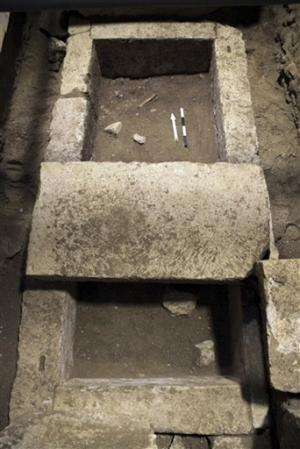Skeleton could solve riddle of ancient Greek tomb

Bones from a skeleton found in the innermost chamber of a huge, looted tomb in Greece could help archaeologists solve the riddle of who was buried there in opulent splendor, during the twilight of Alexander the Great's reign in the late 4th century B.C.
A Culture Ministry statement on Wednesday said the bones were strewn in and around a rectangular stone-lined cist, under the floor of the cavernous, vaulted structure that is 8 meters (26 feet) tall.
The skeleton had initially been placed in a wooden coffin that rotted away, leaving behind the nails that held it together and some carved ivory and glass ornaments.
In an excavation over the past three months near ancient Amphipolis, 600 kilometers (375 miles) north of Athens, Greek archaeologists have uncovered a three-chamber tomb decorated with marble statues of sphinxes and young women, and a large mosaic pavement.
"It is an extremely expensive construction, whose cost, clearly, is unlikely to have been borne by a private citizen," the ministry statement said. Excavator Katerina Peristeri said the occupant was probably some "outstanding personality, a great general" who later enjoyed hero worship.
The mystery has gripped Greece for months. Michalis Tiverios, a professor of archaeology at the University of Thessaloniki, said the human remains should provide valuable information on the occupant of the tomb, which at about 15 meters long and 4.5 meters wide is one of the biggest ever found in the country.
"It's a very important find because it will help us learn the sex of the person buried there, and possibly their approximate age," he told the AP.

Tiverios, who was not linked with the excavation, said one possible candidate would be Nearchos, one of Alexander's closest aides who led his fleet back from India to modern Iraq, and who grew up in Amphipolis.
Alexander, the ancient Greek warrior-king who built an empire from modern Greece to India, died in Babylon in 323 B.C. and was buried in the city of Alexandria, which he founded, in Egypt. The precise location of his tomb is one of the biggest unanswered questions of archaeology.
His generals fought over control of the empire for years, during which wars Alexander's mother, widow, son and half-brother were all murdered—most near Amphipolis.

Wednesday's ministry announcement confirmed what archaeologists had suspected from the outset—and officials for a long time denied—that the tomb had been thoroughly and repeatedly plundered during antiquity.
"Whatever objects of value the first thieves missed was taken by others later," Tiverios said.
-

This picture provided by Greece's Culture Ministry on Thursday, Oct. 16, 2014, shows a large, damaged mosaic floor of the ancient Greek god of the underworld, Pluto, abducting the goddess Persephone on a horse-drawn chariot as the god Hermes looks on, found in a large 4th century B.C. tomb at Amphipolis in northern Greece. Bones from a skeleton found in the tomb's innermost chamber could help solve the riddle of who was buried in opulent splendor there. A Culture Ministry statement on Wednesday, Nov. 12, 2014, said the skeleton was strewn in and around a rectangular stone-lined cist, under the floor of the cavernous, vaulted structure that is 8 metres (26 feet) tall. (AP Photo/Greek Culture Ministry) -

This picture provided by Greece's Culture Ministry on Wednesday, Nov. 12, 2014, shows surviving fragments of carved bone, right, and glass coffin ornaments found in a large 4th century B.C. tomb under excavation at Amphipolis in northern Greece. Bones from a skeleton found in the tomb's innermost chamber could help solve the riddle of who was buried in opulent splendor there. A Culture Ministry statement on Wednesday, Nov. 12, 2014, said the skeleton was strewn in and around a rectangular stone-lined cist, under the floor of the cavernous, vaulted structure that is 8 metres (26 feet) tall. (AP Photo/Greek Culture Ministry) -

This picture provided by Greece's Culture Ministry, Oct. 20, 2014, shows the broken-off head of a marble sphinx, one of a pair that decorated the entrance of a large 4th century B.C. tomb under excavation at Amphipolis in northern Greece. Bones from a skeleton found in the tomb's innermost chamber could help solve the riddle of who was buried in opulent splendor there. A Culture Ministry statement on Wednesday, Nov. 12, 2014, said the skeleton was strewn in and around a rectangular stone-lined cist, under the floor of the cavernous, vaulted structure that is 8 metres (26 feet) tall. (AP Photo/Greek Culture Ministry) -

This picture provided by Greece's Culture Ministry in Aug. 26, 2014, shows a protective shelter excavators built over the entrance - decorated with headless marble sphinxes to a large 4th century B.C. tomb under excavation at Amphipolis in northern Greece. Bones from a skeleton found in the tomb's innermost chamber could help solve the riddle of who was buried in opulent splendor there. A Culture Ministry statement on Wednesday, Nov. 12, 2014, said the skeleton was strewn in and around a rectangular stone-lined cist, under the floor of the cavernous, vaulted structure that is 8 metres (26 feet) tall. (AP Photo/Greek Culture Ministry)
© 2014 The Associated Press. All rights reserved.


















